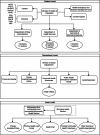Impact of federalization for health financing and workforce in Nepal
- PMID: 37291678
- PMCID: PMC10249211
- DOI: 10.1186/s41256-023-00304-3
Impact of federalization for health financing and workforce in Nepal
Abstract
The adoption of its 2015 constitution has converted Nepal to a federal government while simultaneously resulted in significant reforms of the health system in Nepal in terms of both structure and commitment. In this commentary, we review evidence ranging from health financing to health workforce development to show that the impact of federalization on Nepal's health system and its efforts to achieve equitable and affordable universal health care have been mixed. On the one hand, careful efforts of the federal government to support subnational governments during the transition appears to have avoided serious disruption, subnational governments have successfully taken on the financial burden of the health system, and increase subnational control has allowed more flexible adaptation to changing needs than might have otherwise been possible. On the other hand, financing resource and ability disparities across subnational governments contributes to significant disparities in workforce development, and subnational authorities appear to have underestimated significant health issues (e.g. NCDs) in their budgets. We then provide three recommendations to improve the success of the Nepalese system: (1) to assess whether the services covered by health financing and insurance schemes like the National Health Insurance Program adequately address the needs of the rising burden of NCDs in Nepal, (2) to set clear minimum requirements on key metrics for subnational health systems, and (3) to extend grant programs to address resource disparities.
Keywords: Decentralization; Federalization; Financing; LMICs; Nepal; Non-communicable diseases (NCDs); Universal Health Care (UHC); Workforce.
© 2023. The Author(s).
Conflict of interest statement
The authors declare that they have no competing interests. Hao Li is the Editor in Chief of Global Health Research and Policy. Biraj Karmacharya is an editorial board member of Global Health Research and Policy. They were not involved in the review of decision related to this article.
Figures

References
-
- Ministry of Health Bagmati province. Annual Report Fiscal Year 2017–2018. Hetauda, Nepal: Government of Bagmati Province, 2022.
-
- Ministry of Health and Population (MoHP). Ministry of Health and Population Organogram. Kathmandu, Nepal: MoHP,2023.
-
- Bhattarai S, Arjyal A, Subedi M. Opportunities and challenges of implementing Federal Health System in Nepal at the time of the COVID-19 pandemic. Dhaulagiri J Sociol Anthropol. 2022;16(01):22–35. doi: 10.3126/dsaj.v16i01.50935. - DOI
-
- Federal Ministry of Health and Population (FMoHP), British Embassy Kathmandu (BEK), Nepal Health Sector Support Programme (NHSSP). Health Sector Budget Analysis: First Five Years of Federalism. Kathmandu, Nepal: FMoHP, BEK, and NHSSP, 2022.
Publication types
MeSH terms
LinkOut - more resources
Full Text Sources

